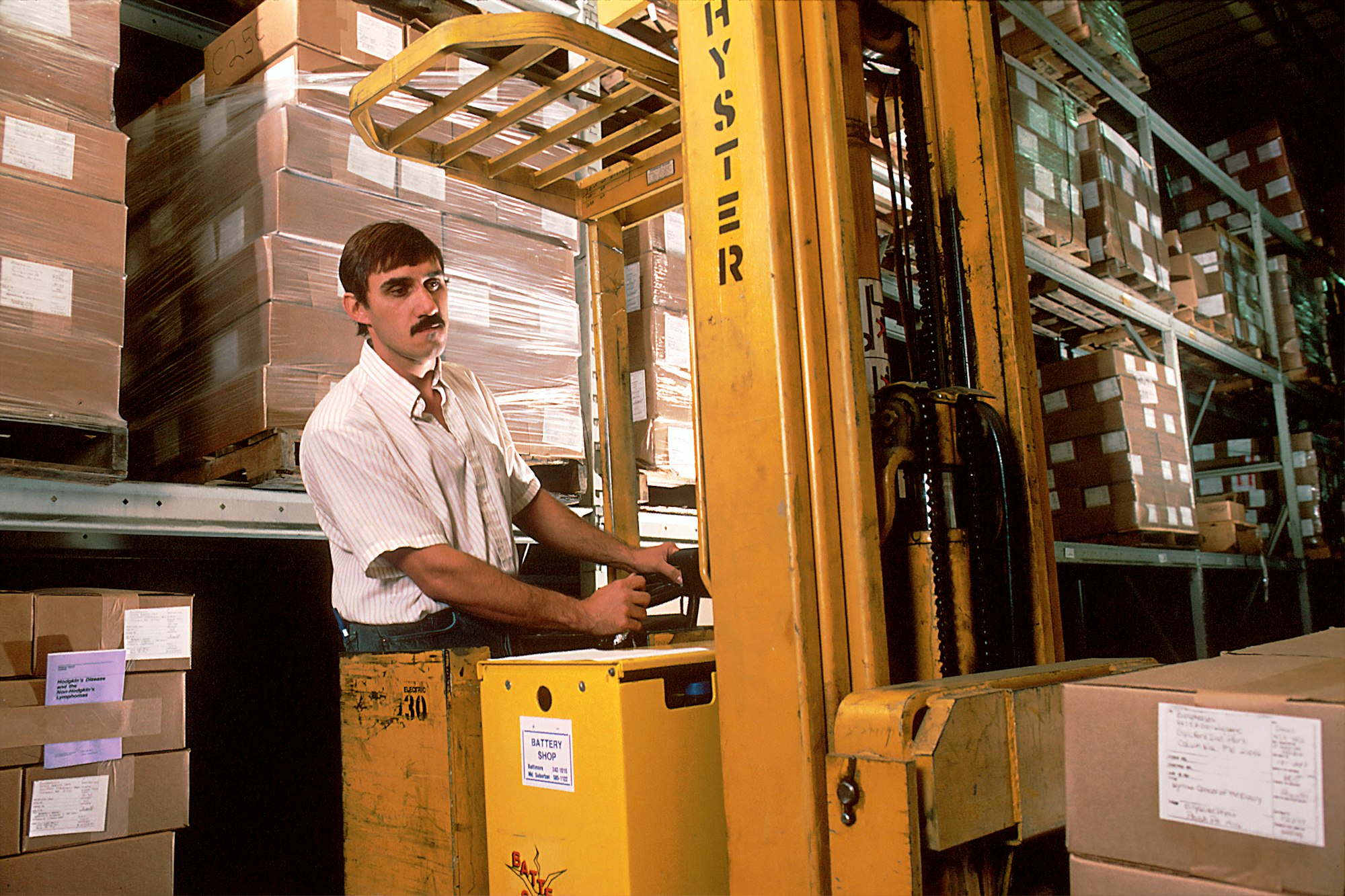Pick-Pack-Ship describes the in-house order fulfillment process of picking products within a warehouse, packing them in the appropriate packaging, and shipping them out promptly.
Is business picking up for your growing company, but an inefficient order fulfillment process causes a bottleneck? Improve your in-house warehouse operations by creating an efficient pick-pack-ship system!
With ERP.AI, businesses can automate and optimize each stage of the fulfillment cycle—right from intelligent order picking to real-time inventory updates and faster shipping coordination—ensuring accuracy, speed, and customer satisfaction.

What is Pick-Pack-Ship?
Pick-Pack-Ship describes the in-house order fulfillment process of picking products within a warehouse, packing them in the appropriate packaging, and shipping them out promptly. Most companies have a form of pick-pack-ship system in place, regardless of the scale of their operations. However, with the help of technology, you can optimize each stage and have greater visibility on each order during the fulfillment process.
Imagine that you are out on an errand run. You have to grab your laundry at the cleaners, pick up some pizza, and buy some snacks and other groceries at the supermarket before you catch the SuperBowl kickoff at 6:30 pm.
There are two approaches to this:
- You start heading to your first destination without planning out your route and to-do list. This might result in you backtracking at specific points, going round in circles, or even missing out on some items. Without proper planning, you struggle to remember what was needed and miss the kickoff!
- From your start point, you plan the most efficient route for you using a GPS to drive to all three locations without having to backtrack. You also prepare a checklist on your phone to make sure that you pick up everything that is needed. You manage to complete all your errands and still make it in time for kickoff.
It goes without saying that the second approach ensures that you get what you need in the shortest time possible. This is what an efficient pick-pack-ship system can do for your business.
Pick-Pack-Ship: The Pick Stage
The first stage of order fulfilment is the Pick stage. In the Pick stage, the main goal is to pick the correct products required most efficiently for a specific order. Tech-enabled warehouse setups might see the use of handheld bar code scanners, have the ability to map the most efficient route for each picker or the exact location of each product, or even replace human pickers with robots! Companies selling larger quantities or bulkier products may also use equipment such as forklifts and pallets.
Ensure the picking stage goes smoothly by familiarizing the pickers with the warehouse layout (or their assigned zones) so that they can navigate the area with ease when fulfilling a picking list. Optimizing the warehouse setup and bin locations are also crucial! Measures such as grouping commonly ordered products and storing product with size variants in different areas can help to optimize work productivity and minimize picking errors.
What is in a Picking List?

A picking list is a crucial internal document that tells the picker what products needed, and the quantity to be picked for each product.
Although many companies have their own format for their picklist, standard information found on a picklist includes:
- Picklist documentation number and generation date
Each picklist is labelled with a unique documentation number that allows you to differentiate it from other picklists. The picklist generation date tells you when the picklist was created.
- Warehouse details
The warehouse details indicate the warehouse that this picklist is assigned to. This is especially useful when a business has multiple warehouses, as it clarifies which warehouse the products should be picked from.
- Picker details
Some companies keep track of the picker that is assigned to a picking list for quality control purposes.
- Invoices that are involved in the current picking list
For pick-pack-ship setups where the picker has to pick for various orders at one time, this section informs which invoices the picker is picking for.
- Ship By Date
The Ship By Date indicates the latest date the order should be shipped out for it to reach the customer by the estimated ship date. Pickers should ensure that the required products are picked and pushed to the next stage in time.
- Stock Keeping Unit (SKU) and description of the product
The SKU is a unique identifier for each product. Some picklists may display the SKU in barcode format for pickers with handheld barcode scanners so that they can easily update the quantity picked.
The description of the product simply describes the product to be picked and is an alternative identifier for the picker.
- Location of the product in the warehouse
Listing the exact location of the product (aisle, shelf, bin) is extremely helpful in ensuring that the picker knows where exactly to look for the required goods. This is especially vital for businesses that deal with products with hard-to-distinguish visual traits.
- Quantity of product to be picked
Lastly, the quantity of product required informs the picker the number of each product is needed to complete the orders involved.

4 Common Picking Strategies Used in Pick-Pack-Ship
There are various picking strategies a business can implement at the Pick stage. Here are 4 of the most common picking strategies used - some of these strategies can even be combined!
Piece/Discreet Picking
Piece/discreet picking describes a process where each packer is only working on a single order at any time. The picker must complete picking for their current order before taking up another one. Even though it has the lowest margin of error, it is also the slowest picking strategy. This method is only reserved for businesses with a lower volume of orders and a smaller set of SKUs.
Batch Picking
Batch picking is similar to piece/discreet picking, but each packer can work on more than one order at a time. This method is simple to execute and excels best when your orders often consist of the same few SKUs, saving multiple trips back and forth.
Zone Picking
For zone picking, the warehouse is split into various zones. Packers are assigned to a specific zone and are tasked with picking products within their designated area. One method of zone picking involves picked products passed from zone to zone until the entire order is picked and placed in the same cart to be sent for packing.
Another alternative approach is to collect picked products from each area and sort them by their respective orders. Zone picking is ideal for larger businesses that have space and resources required to set up zones, and can also be combined with batch picking.
Wave Picking
Wave picking requires orders to be grouped together based on shared traits such as a common shipping carrier or a shared shipping destination. The "wave" in wave picking refers to the timed sessions or "waves" where pickers pick for orders categorized in the same group.
When executed well, orders will be picked at a much faster rate as compared to piece or batch picking. However, implementing wave picking can be too complicated and costly. This method is only viable when the business has a large and steady volume of orders.
Puzzled about the best picking strategy for your business? Answer these questions to help you come to a decision:
- What is my order volume?
- Do I have a large variety of SKUs?
- In a day, when does order volume peak? When does it dip?
- With my current warehouse space constraints and resources, what picking strategy can I implement?
- Do I have enough resources to invest in a bigger space that can facilitate a more efficient picking strategy?
- Do I have enough resources to hire more workers or purchase more equipment to support a more complex picking strategy?

The Pack Stage
After the products have been picked, they will move on to the Pack stage. In the Pack stage, products are packed into parcels or other appropriate packaging. Depending on your picking strategy and setup, products might already be separated by order. Otherwise, consolidation of orders may also fall under the packer's purview.
Additionally, some larger companies may use highly specialized packing or inventory management software that can advise on the parcel size and infill required for each order.
What is in a Packing/Shipping Slip?

Packing slips can be both internal and customer-facing documents. Other than informing packers what needs to be packed, the customer also uses the packing slip to check if they have received everything. The packing slip is usually packed into the parcel alongside the products. However, some companies may combine the packing slip and shipping label, which is placed on the packaging itself.
Elements that you may find in a packing slip include:
- Packing slip documentation number
A unique number that differentiates each packing slip. Used to keep track of packing slips created.
- Invoice details
This usually includes the invoice number and invoice date and allows the customer to know which order was delivered.
- Company address and contact details of the seller
Having your business contact details readily visible allows the customer to contact you promptly if there are any discrepancies with the order.
- Shipping addresses of the seller and the customer
The shipping addresses denote the source and the destination of the parcels delivered.
- Description of goods shipped*
As an internal document, the description of goods tells the packer what to pack for the order. Customers also refer to this to check if all the listed goods are packed for their order.
*Some companies also may choose to include the prices of each item on the packing slip. However, this is not necessary if you have already issued an invoice.
- Personalized messages
As customers typically check the packing slip to make sure that everything is delivered, businesses have utilized this fact to include personalized messages and promotional material. This can be presented in the packing slip itself, or as a separate insert in the parcel.

The Ship Stage
In the last stage, packaged orders are labelled with the appropriate shipping label and passed on to either a third-party courier service or the company's in-house delivery fleet.
What is in a Shipping Label?

Shipping labels are placed on the exterior of the parcel. They include essential information for the courier such as the delivery address and the weight. Most courier services have shipping label generators on their website.
Common elements that can be found in a shipping label include:
- Postage stamp (physical/digital)
Most shipping labels nowadays have upgraded from actual postage stamps to digital stamps printed in a 2D barcode. These can either be rectangular or take a more square form, similar to a QR code. This section may also include more information such as the postage paid and type of delivery service rendered.
- Carrier and shipping service name
The banner section denotes the carrier, and the shipping service purchased. Most carriers also use symbol blocks ("P" in the example above) to indicate the services provided for the labelled parcel.
- Address of the mailer (seller)
The address of the mailer (seller) informs the delivery carrier of the return address if the delivery fails. This address is usually your business or warehouse address.
- Shipping address of the recipient (customer)
The address of the customer is needed for the carrier to deliver the goods to the correct location.
- Parcel tracking number
The parcel tracking number is used by the carrier to identify and update the shipping status of the parcel. Additionally, most shipping carriers allow you to check the shipping status of a package on their website as long as you have the tracking number. It is usually presented in a 1D barcode and number format.
- Shipment date
Shipment date indicates when the package should be picked up by the carrier. In your business's point-of-view, it is the date the parcel leaves your warehouse.
- Parcel number and weight of total shipment/weight of the individual parcel
The parcel number indicates the number of parcels involved in a shipment. In the example above, this order consists of 3 packages (1 of 3).
The weight of the parcels plays a part in how much it would cost to ship the package, as it affects what route is viable for the carrier.

How Does Pick-Pack-Ship Affect Accounting Practices?
When using Pick-Pack-Ship, the accounting treatment is relatively straightforward: once the goods have been shipped, your inventory must be updated accordingly.
For example, James has ordered some clothes totaling $600 from your store. The clothes sold to James were purchased at $500. Your business issues him an invoice, and the following journal entry is posted:
| Accounts | Debit (Dr) | Credit (Cr) |
|---|---|---|
| Accounts Receivable (James) | $600 | |
| Sales | $600 |
Accounts receivable represents the amount owed to your company by customers (such as James). The Sales account captures all sale transactions made in your business.
After the invoice is processed, details of the order are sent to your warehouse staff. Your warehouse then picks, packs, and ships the order to James. Once the shipment is complete, the following journal entry must be posted:
| Accounts | Debit (Dr) | Credit (Cr) |
|---|---|---|
| Cost of Goods Sold | $500 | |
| Inventory | $500 |
As the Inventory account is of a debit nature, crediting the Inventory Account signifies a reduction of value (as $500 worth of goods have left the company's hands). The cost of goods sold account is used to calculate net profit in the profit and loss statement.

What Are The Benefits of Implementing An Efficient Pick-Pack-Ship System?
Some people might overlook their in-house fulfillment process and choose to allocate resources to other aspects of the business. However, spending time to improve your pick-pack-ship process might reap more benefits than you might think.
Faster Fulfillment Times
By allocating resources to improve your pick-pack-ship process, you minimize delays when the product is moving through your warehouse. Small improvements such as the re-arrangement of your products and shelves in the warehouse or introducing the use of handheld barcode scanners can make a difference.
Lower Chance Of Returned Goods

By improving your pick-pack-ship process, you can ensure that your products are packed securely and with the correct items. This dramatically reduces the chances of goods being returned or exchanged between you and the customer, which also lowers undesirable expenses such as return shipping.
Happier Customers
Ultimately, having shorter fulfillment times and receiving the correct products intact and as ordered will result in a better shopping experience for your customers. Customers with a good experience shopping with your brand are more likely to place recurring orders or even introduce the brand to their friends and family.
Fulfillment Method Showdown: Pick-Pack-Ship Vs. Dropshipping
Despite its benefits, pick-pack-ship might not be the ideal fulfillment method for some companies due to resource or space limitations. We compare pick-pack-ship with another popular fulfillment method: dropshipping.
| Traits | Pick-Pack-Ship/In-House Fulfillment | Dropshipping |
|---|---|---|
| Cost to Setup | Hiring and training warehouse staff, rental or purchase of warehouse space and equipment is required, and can become quite costly during initial setup. | Cheaper to start as there is no need to invest in warehouse space, personnel or equipment. |
| Inventory Management | Greater control and visibility of product stock levels. Warehouse managers must constantly monitor and ensure that there is sufficient stock to operate. Quality control and quality assurance tests can be conducted with minimal restrictions. | As dropshipping does not involve holding inventory, there is no inventory management required. However, product stock levels may not be updated real-time as it is maintained by the supplier, and can cause problems when ordered products are out of stock. It is harder to conduct quality control and quality assurance tests, and the business is heavily reliant on the dropship supplier to maintain the standard expected. |
| Turnaround time | Once the order is received, businesses can start order processing almost immediately. | Turnaround time is longer as business has to place order via dropshipping supplier, which might take time to respond. |
| Branding | As the business has better visibility of the order status and is involved in pick and pack, they have control of the customer's experience with the brand. | Order picking and packing is done completely on the supplier's end and business has limited visibility and control. Introducing brand-specific components such as inserts or packaging might be restricted or costly to implement. |
| Profit-margin | Overall profit-margin can be increased as the business invests resources to improve the efficiency of the fulfillment process. | As inventory management and fulfillment is outsourced to the dropshipping supplier, profit-margin cannot be improved in this aspect, and is often lower than in-house fulfillment. |
In conclusion, pick-pack-ship allows better control of the customer experience and branding as compared to dropshipping. Even though it may cost more in the initial setup, we recommend in-house fulfillment as you can exercise more control to prevent a negative customer experience.
Furthermore, you can also choose to implement both. Some companies use dropshipping as a complementary fulfillment method to reduce shipping times for different locations, or to support crunch periods.
How AI Improves Order Fulfillment Operations
From optimizing picking routes to automating packing decisions, AI helps reduce manual effort and minimize errors. It can forecast demand patterns, streamline inventory tracking, and adjust workflows in real time to meet changing customer needs.
This leads to quicker deliveries, better resource allocation, and enhanced customer satisfaction. By using AI for predictive insights and workflow automation, companies can scale their operations and stay competitive in today’s fast-paced fulfillment landscape.
How Deskera Books Lets You Manage Pick-Pack-Ship With Ease
In Deskera Books, you have full control over order processing and fulfillment, as both order processing and inventory management are integrated into a single software.
Pick pack Ship in Deskera Books

We have a simple-to-use Pick-Pack-Ship feature that allows pickers to view the picklist for each order. Your warehouse staff can even use the Deskera mobile app to scan barcodes to update product quantity picked instead of relying on pen and paper or having to invest in handheld barcode scanners.

In the Pack stage, your packers can access the packing slip easily and indicate the number of cartons used, and quantity of products packed in each carton.

Lastly, in the Ship stage, you can indicate essential details such as tracking number and box dimensions. Deskera Books has its own shipping label template that can be easily printed out and used for your parcel. With in-app integrations available with FedEx and USPS, you can easily track your customer's order even after it has left your warehouse.
Here is some further reading that you may find helpful:








